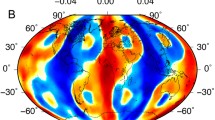Abstract
—Recently a high-resolution tomographic model, the P1200, based on P-wave travel times was developed, which allowed for detailed imaging of the top 1200 km of the mantle. This model was used in diverse ways to study mantle viscosity structure and geodynamical processes. In the spatial domain there are lateral variations in the transition zone, suggesting interaction between the lower-mantle plumes and the region from 600 km to 1000 km. Some examples shown here include the continental region underneath Manchuria, Ukraine and South Africa, where horizontal structures lie above or below the 660 km discontinuity. The blockage of upwelling is observed under central Africa and the interaction between the upwelling and the transition zone under the slow Icelandic region appears to be complex. An expansion of the aspherical seismic velocities has been taken out to spherical harmonics of degree 60. For degrees exceeding around 10, the spectra at various depths decay with a power-law like dependence on the degree, with the logarithmic slopes in the asymptotic portion of the spectra containing values between 2 and 2.6. These spectral results may suggest the time-dependent nature of mantle convection. Details of the viscosity structure in the top 1200 km of the mantle have been inferred both from global and regional geoid data and from the high-resolution tomographic model. We have considered only the intermediate degrees (l = 12–25) in the nonlinear inversion with a genetic algorithm approach. Several families of acceptable viscosity profiles are found for both oceanic and global data. The families of solutions for the two data sets have different characteristics. Most of the solutions asociated with the global geoid data show the presence of asthenosphere below the lithosphere. In other families a low viscosity zone between 400 and 600 km depth is found to lie atop a viscosity jump. Other families evidence a viscosity decrease across the 660 km discontinuity. Solutions from oceanic geoid show basically two low viscosity zones one lying right below the lithosphere; the other right under 660-km depth. All of these results bespeak clearly the plausible existence of strong vertical viscosity stratification in the top 1000 km of the mantle. The presence of the second asthenosphere may have important dynamical ramifications on issues pertaining to layered mantle convection. Numerical modelling of mantle convection with two phase transitions and a realistic temperature- and pressure-dependent viscosity demonstrates that a low viscosity region under the endothermic phase transition can indeed be generated self-consistently in time-dependent situations involving a partially layered configuration in an axisymmetric spherical-shell model.
Similar content being viewed by others
Author information
Authors and Affiliations
Additional information
Received November 5, 1996, revised July 15, 1997, accepted July 17, 1997
Rights and permissions
About this article
Cite this article
Čadek, O., Yuen, D., Čížková, H. et al. New Perspectives on Mantle Dynamics from High-resolution Seismic Tomographic Model P1200. Pure appl. geophys. 151, 503–525 (1998). https://doi.org/10.1007/s000240050126
Issue Date:
DOI: https://doi.org/10.1007/s000240050126




